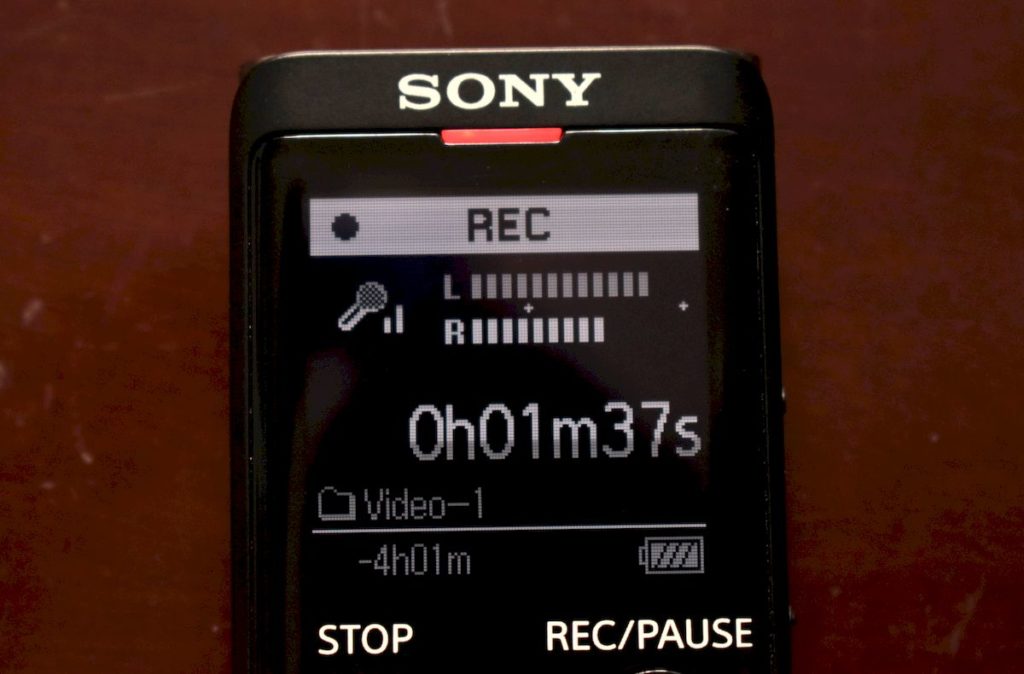The Sony ICD-UX570 is a refresh of the Sony ICD-UX560.
TL;DR: Buy the cheaper model.
To start us off, let’s look at the specifications of the two recorders.
| Product Name | Sony ICD-UX560 | Sony ICD-UX570 |
| Product Dimensions | 1.44 x 4 x 0.41 inches | 1.45 × 4.05 × 0.49 inches |
| Recording Formats | LPCM (WAV), MP3 | LPCM (WAV), MP3 |
| Internal Storage | 4GB, microSDXC expansion | 4GB, microSDXC expansion |
| Microphones | Stereo microphones | Stereo microphones |
| Ports | 3.5mm microphone input, 3.5mm headphone output, USB 2.0 for PC & Mac | 3.5mm microphone input, 3.5mm headphone output, USB 2.0 for PC & Mac |
| Internal Battery | 3.7v Lithium ion | 3.7v Lithium ion |
| Release Date | October 2015 | December 2019 |
| Check Price on Amazon | Check Price on Amazon |
As you can see, the two recorders are very similar, and here’s a detailed review of the Sony ICD-UX570 and the Sony ICD-UX560. But there are some differences.
Build

The UX570 is slightly larger than the UX560. The UX570 is slightly thicker, but with the rounded edges, it’s barely noticeable. On the UX570 the speaker has moved to the left side, while on the UX560 it’s at the bottom.
On the UX570, the Back, T-Mark and Option buttons have moved to below the display, and they have been replaced with 3 new playback buttons.
Display
The display on the UX570 is about 10% larger. But more importantly, they have redesigned the layout of the record window and added the recording folder to the display. So, it’s very easy to tell which folder you are recording into – very useful.
In addition, you get a larger recording LED on the ux570 and it has moved to below the Sony logo.

On the UX560, you get recording peak meters. The peak meters indicate the recording volume in dB. That’s changed on the UX570. You no longer have meters, but you do get recording guides. And the recording guides, for left and right channel have pluses. The space between the pluses indicates the appropriate range for the recording level.
So they have simplified the metering, removed the dB meter and placed guides.
Personally, I liked the dB meter on the UX560. But I understand that to users who don’t know what’s a dB and the appropriate dB for recording quality audio, they might have been overly complicated.
Battery Life
The Sony ICD-UX560 came with a 230mah 3.7v lithium ion internal battery. They UX570 also comes with a 3.7v lithium ion internal battery, but from the specifications it seems like the capacity has reduced; you get a slight reduction in battery life. The only sure way to tell if the ux570 has a lower capacity battery is to open it up; I don’t plan to do that!
Recording Quality
This is where the ux570 shines. The internal circuit of the UX570 produces less noise than the UX560. And that’s a big deal. Because, in similar settings, the UX570 records less background noise.
In addition, the Noise Cut Filter (NCF) on the UX570 has a larger effect than on the ux560. So if you use the NCF on the UX570, a lot of the low and high frequencies are reduced. Now, I generally record in quiet locations and I found that when I used the NCF on the UX570 I lost a lot of the bass in the recording.
While I recommend always using the NCF on the UX560 when you’re making voice recordings, on the UX570 you only need to use the NCF if you are recording in a location with a lot of noise.
Here’s an in-depth look at the NCF and LCF on the UX560, if you’d like me to pen a similar one for the UX570, let me know in the comments section below.
Bottom line
If you are looking to make a buying decision between the UX560 and the UX570, here’s my advice:
Head over to Amazon (I’ve found Amazon offers the lowest prices) and compare the price of the UX560 and UX570. Whichever is cheaper, buy it.
There’s very little that differentiates the UX560 from the UX570.
My guess is that Sony will discontinue (or already has) the production of the UX560. Because of demand vs supply, the UX560 is going to cost more than the UX570. As I pen this, the UX560 is $23 more expensive than the UX570 on Amazon. But as demand ramps up for the UX570 in a few months and goes down for the UX560, you may find that the UX570 will become more expensive than the UX560.
So, check the prices and buy the cheaper model.
That’s it for this post. If you have any questions or suggestions, please post them in the comment section below.



Leave a Reply